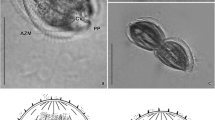Summary
Information has been provided for the first time on the fine structure of the tip and base of a haptonema, the organism being that already studied in a preliminary way in Manton and Leedale 1963 a. The tip structure is unexpectedly simple, with the haptonema cavity interposed between the rounded apex of the core and the external wall of the organelle. The base has been shown to be unexpectedly complex in that the number of core fibres, which alone enter the cell deeply, changes progressively from 7 at the surface to 9 at the extreme base. The possible meaning of these observations is discussed in a preliminary way.
Zusammenfassung
Es wird zum ersten Mal über die Feinstruktur sowohl des Endes als auch des Basalstückes eines Haptonemas berichtet. Der Organismus selbst wurde schon früher von Manton u. Leedale (1963a) untersucht. Die Struktur des Endes ist unerwartet einfach, indem der cylindrische Hohlraum des Haptonemas zwischen dem abgerundeten Apex des Zentralstückes und der Außenwand des Organelles liegt. Das Basalstück hingegen erwies sich als unerwartet kompliziert gebaut. Die Zahl der Fibrillen, die alleine ins Zellinnere eintreten, ändert sich sukzessiv von sieben an der Oberfläche auf acht und schließlich auf neun an der Basis. Die möglichen Schlußfolgerungen dieser Beobachtungen werden vorläufig diskutiert.
Similar content being viewed by others
References
Ledbetter, M. C., and K. R. Porter: A “microtubule” in plant cell fine structure. J. Cell. Biol. 19, 239–250 (1963).
Luft, J. H.: Improvements in epoxy resin embedding methods. J. biophys. biochem. Cytol. 9, 409–414 (1961).
Manton, I.: The possible significance of some details of flagellar bases in plants. J. roy. Microscop. Soc. 82, 279–285 (1964a).
—: Observations with the electron microscope on the division cycle in the flagellate Prymnesium parvum. Carter. J. roy. Microscop. Soc. 83, 317–325 (1964b).
—, and G. F. Leedale: Further observations on the fine structure of Chrysochromulina ericina Parke and Manton. J. Mar. Biol. Ass. U. K. 41, 145–155 (1961).
——: Observations on the fine structure of Prymnesium parvum Carter. Arch. Mikrobiol. 45, 285–303 (1963a).
——: Observations on the micro-anatomy of Chyrystallolithus hyalinus Gaarder and Markali. Arch. Mikrobiol. 47, 115–136 (1963b).
Millonig, G.: A modified procedure for lead staining of thin sections. J. biophys. biochem. Cytol. 11, 736–740 (1961).
Parke, M., J. W. G. Lund, and I. Manton: Observations on the biology and fine structure of the type species of Chrysochromulina (C. parva Lackey) in the English Lake District. Arch. Mikrobiol. 42, 333–352 (1962).
Reynolds, S.: The use of lead citrate at high pH as an electron opaque stain in electron microscopy. J. Cell Biol. 17, 208–211 (1963).
Author information
Authors and Affiliations
Rights and permissions
About this article
Cite this article
Manton, I. Further observations on the fine structure of the haptonema in prymnesium parvum. Archiv. Mikrobiol. 49, 315–330 (1964). https://doi.org/10.1007/BF00406854
Received:
Issue Date:
DOI: https://doi.org/10.1007/BF00406854




